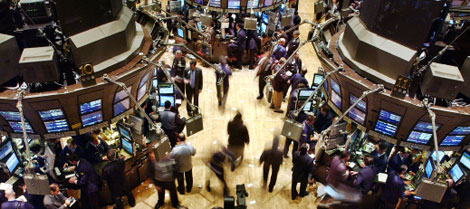If this market runs out of bears, I think it’s in trouble.
And today one of the market’s few remaining bears capitulated to the rally. Wells Fargo’s head of equity strategy Christopher Harvey hiked his year-end price target for the Standard & Poor’s 500 Index to 3,088 from 2,665. The index closed at 2,983 on Monday April 29, so the Wells Fargo target is 4.9% above Monday’s close. The previous Wells Fargo target was the second lowest on Wall Street. It’s now the second highest, according to Bloomberg, behind only the 3250 target from Deutsche Bank. (The only call lower than that of Wells Fargo before this bullish shift was from Cantor Fitzgerald.) The median is 2,950.
What’s really interesting to me about Harvey’s call at Wells Fargo is that it’s based on higher price-to-earnings ratios and not on increasing earnings themselves. Because of the Federal Reserve’s switch to steady or even declining interest rates, and because of an investor preference for U.S. equities based on their outperformance, investors will be willing to pay more for U.S. stocks as the year goes on, Harvey argued. Harvey did not raise his target for S&P 500 earnings from his earlier $166 for 2019.
So this is an example of a call that in my opinion is based on “fear of being left out.” No analyst likes to be bearish in the face of a rally like this. And at some point the pain of being bearish just gets to be too much. You can be sure that the phones have been ringing off the hooks at Wells Fargo as money management clients have been calling to question the previous bearish positioning.
For those of us made a bit uneasy by the market’s continued climb in the face of lackluster earnings–and who worry about the size of Fed’s balance sheet and the stimulus to the economy from big government deficits–the move to bullish from bearish by one of Wall Street last bearish holdouts is another worrying sign. This rally has been supported, in part, by bears tossing in the towel and joining the bullish chorus. That works to drive up stock prices as long as there’s cash on the sidelines moving into the market to buy shares. When, however, the supply of bears is running low, then the market will have to find other reasons to move higher.
And if you suspect, as I do, that the U.S. economy will slow in the second half, those “reasons” look to be in limited supply for the latter part of 2019.



Different rigged markets are rigged in different ways. 1999-2000 market was rigged in that companies, remember Nortel?, were lying about revenue. This one is rigged in the sense that it is totally dependent on cheap money from central banks–and governments like ours are putting pressure on to make money even cheaper. Lots follows from that….
Jim, can you ever remember a time in history where the stock market felt as rigged as it is now? Every day there are carrots dangling of infrastructure spending to trade deals, to Fed being accommodating but the cat never comes out of the bag.